Lathmar Holi brings festive spirit to Nandgaon following vibrant celebrations in Barsana
After the exuberant Holi celebrations in the village of Barsana, the revelry of Lathmar Holi cascaded through Nandgaon, the village…
The magnificence of the festival of Holi lies in the beauty of the different ways in which it is celebrated in different states of India

Colours are the mainstay of Holi festival. (Photo: Getty Images)
March is the month of change as we welcome spring after winter bids us a goodbye. March is also the time for one of India’s most popular and widely celebrated festivals — Holi. Holi is a Hindu festival that is celebrated in India and Nepal, and has spread to other parts of Asia over time. The “festival of colours” marks the victory of good over evil and the arrival of spring. Many people also see Holi as the festival of love as it is an occasion when people come together to play with colours and rejuvenate forgetting all their worries.
The celebration of Holi starts the night before with Holika Dahan when people gather to perform rituals in front of the bonfire and pray for the destruction of evil that resides within us. It is similar to how Holika, the sister of Hirayanakashipu, was burnt as she tried to kill Bhakt Prahlad. The next morning, people celebrate Holi with a splash of colours and water. The magnificence of the festival lies in the beauty of the different ways in which it is celebrated in different states.
Dol Jatra and Basant Utsav, West Bengal
Advertisement
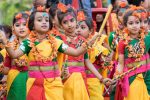
Holi in West Bengal is celebrated as Basant Utsav and Dol Jatra to mark the onset of spring season. The first day is Basant Utsav in which people play with colours and enjoy the festive mood with dance and music programmes. Women dress up in beautiful yellow sarees, signifying the charm of the Basant. The best place in Bengal to view the beauty of the festival is Shantiniketan in Bolpur. On the second day, Dol Jatra is celebrated when people carry idols of Radha and Krishna on the streets in a procession which is made a fun celebration with use of colours and playing of music.
Phaguwa, Bihar
Phaguwa is the local name for Holi in Bihar. On the night before Holi, Holika Dahan is performed by people by lighting a bonfire. Throughout the next day, people celebrate by smearing dry and wet colours on each other to mark the victory of good over evil.
Lathmar Holi , Uttar Pradesh
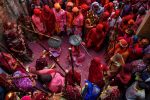
Lathmar Holi is a tradition that got it roots from Hindu mythology. In this traditional celebration of Holi, women hit men with lathis or canes and men protect themselves with a dhal or shield, and they cheerfully play the battle. Lathmar Holi is popularly celebrated in Barsana, Mathura, Vrindavan and Nandgaon. According to myths, Lord Krishna went to play Holi with Radha and women of the village retaliated by hitting him with lathis and sent him away.
Shigmo, Goa
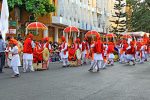
Shigmo festival is a huge spring celebration in Goa. The festival is vibrantly celebrated through a series of traditional folk dances and street performances. Tourists also take part in the celebrations with full enthusiasm.
Hola Mohalla, Punjab
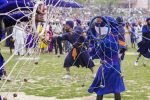
Holla Mohalla is also known as the warrior Holi. This festival is mainly celebrated by Nihang Sikhs to celebrate the bravery of Sikh warriors. The festival is celebrated a day before Holi. The celebration involves exhibition of martial arts and is followed by music and dance.
Yaosang, Manipur
Yaosang is six-day Holi celebration in Manipur. It starts on the day of full moon. The celebration involves burning of huts made of hay and twigs, worshipping Lord Krishna and playing with colours along with other processions. The highlight of the festival is the Manipuri folk dance, Thabal Chonga.
Khadi Holi, Uttarakhand
Khadi Holi is mainly celebrated in Kumaon region of Uttarakhand. It is a musical celebration and people participate with full enthusiasm. People wear traditional clothes, move in tolis around the city, sing traditional songs and greet each other. It is also known as Mahila Holi and Baithaki Holi.
Kama Dahanam, Tamil Nadu, Andhra Pradesh, Telangana, Karnataka
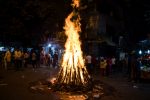
Kama Dahanam is a ritual performed a day prior to Holi in some South Indian states. The festival is associated with Kamadeva (the God of Love) and Lord Shiva. According to the legend, Kamadeva shot his arrows at Lord Shiva to break his meditation but he opened his third eye and burnt Kamadeva to ashes. After Lord Shiva thus conquered his carnal desires, Rati, Kama’s wife, managed to pacify Shiva with the power of her meditative asceticism. Lord Shiva then revived Kama. The day of Kamadeva getting back his life is celebrated as the festival of Holi. Kama Dahanam is similar in nature to Holika Dahan. Dried cow dung balls, dried grass and sticks are burnt as the symbol of Kama, and the ash, considered sacred, is distributed.
Also celebrated as Dhuleti in Gujarat, Rangpanchami in Maharashtra and Dulhandi in Haryana, Holi is not just a festival of colours, but a joyous celebration of humanity. Holi welcomes the fresh and rejuvenating spirit of spring and also gives people an occasion to be happy.
Advertisement